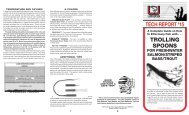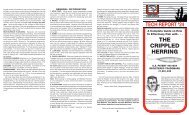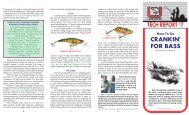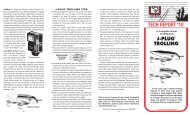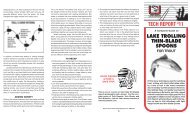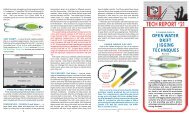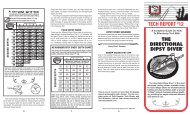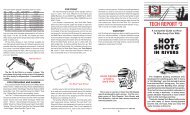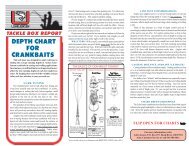Create successful ePaper yourself
Turn your PDF publications into a flip-book with our unique Google optimized e-Paper software.
The truth be known, luck is the least important factor inbecoming a successful angler. The person who employsthe techniques given in this report, who understands troutand their habits and is willing to experiment with differentlures and techniques will consistently out fish those usingother techniques on the same body of water. Knowing thewater you plan to fish, plus knowledge of the feeding andhabitat characteristics of the fish species you’re after arekey ingredients <strong>for</strong> productive angling.Consistent results! That’s the reward, day‐in and day‐out<strong>for</strong> the angler who employs trolling as his or her primaryfishing technique. The reason is simple: an entire lake orreservoir can quickly and efficiently be prospected bytrolling and concentrations of fish can be pinpointed withminimum ef<strong>for</strong>t.<strong>Trolling</strong> requires a boat, a method of propulsion (motoror oars), rod and reel, lake troll and a lure. The lake troll andlure are let out behind your moving boat, with the amountof line dependant upon the size lure and lake troll youselect, along with how deep you wish to fish. The <strong>for</strong>wardspeed of your boat will dictate just how fast or slow thetroll or lure will run and also will control its depth. Oncethe troll and lure are in the water and working properly,you must then find the fish.PROSPECTING A LAKEWhether you’re using a troll, small lure on lead core line,or a lure‐and‐worm combination, you’ll find trout favoringcertain areas of a lake. It saves a lot of time and energyif you are aware of these areas BEFORE you get on thelake and know in advance just what to look <strong>for</strong>.STRUCTURE All fish relate in one way or another tostructure, shelter or cover. They use it <strong>for</strong> protection frompredators, to escape direct sunlight, <strong>for</strong> feeding and, insome cases, <strong>for</strong> spawning. Deep water, docks or otherman‐made structure, overhanging trees, shade, underwaterrocks and cliff areas are all likely to attract and holdfish. <strong>Trout</strong> must have shelter, both from predators and fromdirect sunlight, so they always will be either next to or withineasy reach of a shelter, cover or structure area.TROLL RIGGINGSWIVELSNUBBER#1 NEEDLEFISH ® OR OTHER LURETROLLRUDDERMost lakes stratify into three layers during late spring, staying thatway until late fall. The middle layer of water, the thermocline, containsboth a large amount of dissolved oxygen and <strong>for</strong>age fish. Tobe most effective, you should troll close to or in the thermocline.This will be from 15 to 50 feet down in most lakes.FOOD SOURCES Locate food sources in a given lake,and fish will be found nearby. Minnows, salamanders,crayfish, midges, surface insects, beetles and other suchcreatures make up a large part of a trout’s diet. Watchcarefully <strong>for</strong> surface activity such as a school of small baitfish jumping or <strong>for</strong> insect hatches. On a windy day, fishthat part of the lake where surface food is being blownand concentrated. Try areas adjacent to inlet and outletstreams where food items will be prevalent, or next tograssy shorelines or near marshy, weedy areas where foodis easily available. Overhanging trees or bushes harborall sorts of insect life and fish will be waiting below <strong>for</strong>morsels to drop into the water.DROP-OFFS <strong>Fish</strong> relate to structure and one of the easiestto detect, due to obvious shoreline features, is a drop-off.Be on the lookout <strong>for</strong> steep banks and then troll close toshore, along these banks. A depth finder is a tool that willhelp you locate ledges, drop-offs and underwater islandsnot apparent in any other way. It will save you valuablefishing time in finding these hot spots and allow you totroll next to them accurately.or in the thermocline <strong>for</strong> best results. It will be from 15 to50 feet down in most lakes, depending on size and depth.<strong>Fish</strong> also will regularly be found close to drop-offs, nearinlets or outlet streams where highly oxygenated wateris flowing, or in old river channels which contain residualwater flows.LAKE TROLLSBecause of their popularity, effectiveness and ease ofuse, Luhr-Jensen makes a wide variety of lake trolls. Acomplete listing can be found on the back page of thisreport. Trolls are especially effective in deep or murkywaters and also on overcast days. The basic differencebetween lake trolls is in the number and shape of theirblades and the length of the shaft or cable. The shape of ablade determines how fast it will rotate and the particularsound vibrations it will produce.Shorter, wider blades in relation to their length, such asthe Cowbell ® or Beer Can, swing slow and wide from theshaft while narrow blades, like the Willow Leaf, spin fastand close to the shaft. Narrow bladed trolls are best suited<strong>for</strong> fast trolling as they have less water resistance.Trolls appeal to several fish feeding instincts. In additionto producing flash and other visual attraction, a rotatingblade gives off vibrations underwater that spell f‐o‐o‐dto nearby fish. A troll can be used in conjunction with justabout any lure or bait, three of the most effective being asmall spoon (Needlefish ® , Super Duper ® or Hus‐Lure ),small plug (Hot Shot ® or Kwikfish ® ) or a worm. The trollconsists of a rudder at the front end which prevents linetwist, a series of free‐swinging blades on a wire or cableand a swivel to which you tie a leader. From the end of thetroll, the leader should extend at least 12 inches back tothe lure (many anglers prefer leaders of 12 to 18 inches,but they may range clear up to five or six feet). Whentrolled, the blades act as attractors. <strong>Fish</strong> follow the flashand sound of the lake troll to the source, spot the trailinglure and go after it.Ford Fender Beer Can OXYGENATED WATER Most lakes stratify into threelayers during spring (see the diagram) and stay that way14" - 18" LEADERuntil late fall. The middle layer of water, the thermocline,contains both a large amount of dissolved oxygen and<strong>for</strong>age fish. Your trolling should be concentrated close toSchool-O-Minnows 2 3 4More and larger blades should be used <strong>for</strong> deep trollingor murky water. Clear water or depths of 10- to 20-feetrequire fewer, smaller blades. Nickel finishes work beston bright days or in clear water, while Brass and Copperfinishes produce better in murky, deep or brackish(tea‐colored) water. Brass, 50/50 Brass‐Nickel or Copperfinishes work well when skies are overcast.TROLL-EASE AND RUDDERSIf you are going to use lures or trolls that have a tendencyto spin in the water, a rudder is an essential piece of trollingequipment. The rudder will keep blades tracking straightand prevent your line from twisting. Small rudders should beused whenever you have some concern about line twist.Combining the rudder idea with the need to easilychange weight on a sport fishing line has resulted in theTroll-Ease , a wire‐frame rudder with the added featureof hollow‐core sinker attachment capabilities. It’s oneitem a troller should have several of. Although simple, iteliminates a very big problem of how to change lead oradd or subtract weight without constantly tying knots andcutting off pieces of line. By simply unsnapping a metalpin, you can easily add or subtract the lead you desire.It allows light spin tackle to effectively reach depths ordinarilyattainable only with lead core line or by using adownrigger. An added bonus is that the Troll-Ease alsoacts as a line‐twist‐preventing rudder.TO TROLLTroll-Ease TO RODHOLLOW LEAD WEIGHTSUSING A SNUBBERUsually the strikes that come when trolling are vicious. Ifyou are using a troll or are fishing <strong>for</strong> species known tohave delicate mouths such as kokanee, a rubber snubberis one piece of equipment you’ll be glad you have. Asnubber is a length of surgical tubing with a coiled pieceof heavy line inside and a swivel attached to each end.When a fish strikes, the snubber stretches out to helpabsorb the impact and then retracts.Snubbers are attached between the troll and the leader to thelure and absorb the shock of hard strikes. They are available inlight, medium or heavy‐duty sizes to work with the pound testleader you select.505 <strong>Lake</strong> <strong>Trolling</strong>.indd 2 1/21/09 12:56:30 PM



